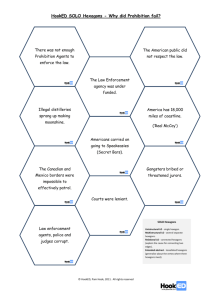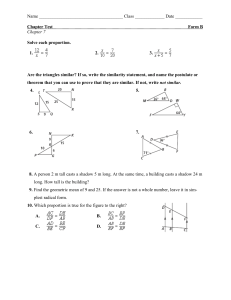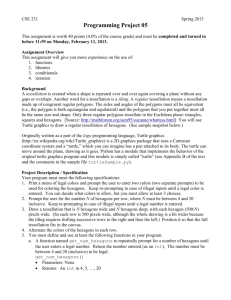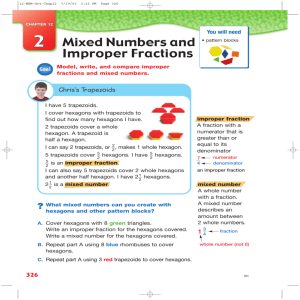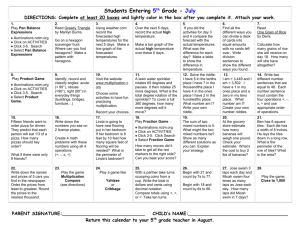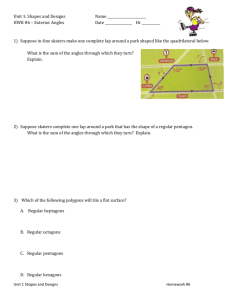Stability of Turing patterns in the Brusselator model
advertisement
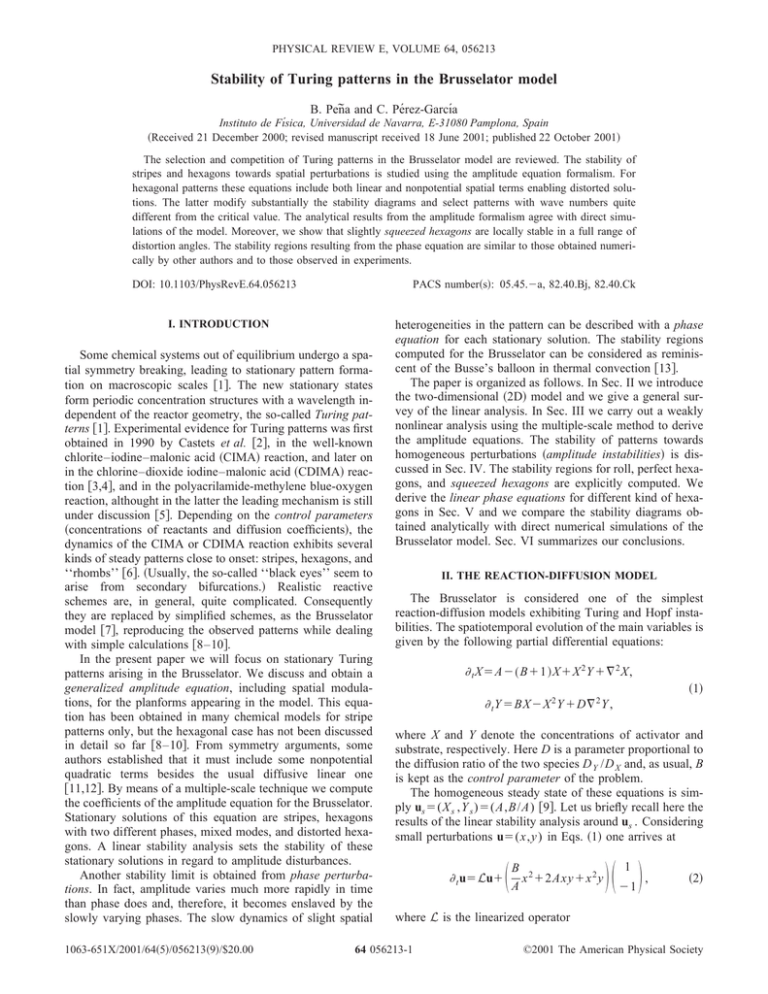
PHYSICAL REVIEW E, VOLUME 64, 056213 Stability of Turing patterns in the Brusselator model B. Peña and C. Pérez-Garcı́a Instituto de Fı́sica, Universidad de Navarra, E-31080 Pamplona, Spain 共Received 21 December 2000; revised manuscript received 18 June 2001; published 22 October 2001兲 The selection and competition of Turing patterns in the Brusselator model are reviewed. The stability of stripes and hexagons towards spatial perturbations is studied using the amplitude equation formalism. For hexagonal patterns these equations include both linear and nonpotential spatial terms enabling distorted solutions. The latter modify substantially the stability diagrams and select patterns with wave numbers quite different from the critical value. The analytical results from the amplitude formalism agree with direct simulations of the model. Moreover, we show that slightly squeezed hexagons are locally stable in a full range of distortion angles. The stability regions resulting from the phase equation are similar to those obtained numerically by other authors and to those observed in experiments. DOI: 10.1103/PhysRevE.64.056213 PACS number共s兲: 05.45.⫺a, 82.40.Bj, 82.40.Ck I. INTRODUCTION Some chemical systems out of equilibrium undergo a spatial symmetry breaking, leading to stationary pattern formation on macroscopic scales 关1兴. The new stationary states form periodic concentration structures with a wavelength independent of the reactor geometry, the so-called Turing patterns 关1兴. Experimental evidence for Turing patterns was first obtained in 1990 by Castets et al. 关2兴, in the well-known chlorite–iodine–malonic acid 共CIMA兲 reaction, and later on in the chlorine–dioxide iodine–malonic acid 共CDIMA兲 reaction 关3,4兴, and in the polyacrilamide-methylene blue-oxygen reaction, althought in the latter the leading mechanism is still under discussion 关5兴. Depending on the control parameters 共concentrations of reactants and diffusion coefficients兲, the dynamics of the CIMA or CDIMA reaction exhibits several kinds of steady patterns close to onset: stripes, hexagons, and ‘‘rhombs’’ 关6兴. 共Usually, the so-called ‘‘black eyes’’ seem to arise from secondary bifurcations.兲 Realistic reactive schemes are, in general, quite complicated. Consequently they are replaced by simplified schemes, as the Brusselator model 关7兴, reproducing the observed patterns while dealing with simple calculations 关8–10兴. In the present paper we will focus on stationary Turing patterns arising in the Brusselator. We discuss and obtain a generalized amplitude equation, including spatial modulations, for the planforms appearing in the model. This equation has been obtained in many chemical models for stripe patterns only, but the hexagonal case has not been discussed in detail so far 关8–10兴. From symmetry arguments, some authors established that it must include some nonpotential quadratic terms besides the usual diffusive linear one 关11,12兴. By means of a multiple-scale technique we compute the coefficients of the amplitude equation for the Brusselator. Stationary solutions of this equation are stripes, hexagons with two different phases, mixed modes, and distorted hexagons. A linear stability analysis sets the stability of these stationary solutions in regard to amplitude disturbances. Another stability limit is obtained from phase perturbations. In fact, amplitude varies much more rapidly in time than phase does and, therefore, it becomes enslaved by the slowly varying phases. The slow dynamics of slight spatial 1063-651X/2001/64共5兲/056213共9兲/$20.00 heterogeneities in the pattern can be described with a phase equation for each stationary solution. The stability regions computed for the Brusselator can be considered as reminiscent of the Busse’s balloon in thermal convection 关13兴. The paper is organized as follows. In Sec. II we introduce the two-dimensional 共2D兲 model and we give a general survey of the linear analysis. In Sec. III we carry out a weakly nonlinear analysis using the multiple-scale method to derive the amplitude equations. The stability of patterns towards homogeneous perturbations 共amplitude instabilities兲 is discussed in Sec. IV. The stability regions for roll, perfect hexagons, and squeezed hexagons are explicitly computed. We derive the linear phase equations for different kind of hexagons in Sec. V and we compare the stability diagrams obtained analytically with direct numerical simulations of the Brusselator model. Sec. VI summarizes our conclusions. II. THE REACTION-DIFFUSION MODEL The Brusselator is considered one of the simplest reaction-diffusion models exhibiting Turing and Hopf instabilities. The spatiotemporal evolution of the main variables is given by the following partial differential equations: t X⫽A⫺ 共 B⫹1 兲 X⫹X 2 Y ⫹ⵜ 2 X, 共1兲 t Y ⫽BX⫺X 2 Y ⫹Dⵜ 2 Y , where X and Y denote the concentrations of activator and substrate, respectively. Here D is a parameter proportional to the diffusion ratio of the two species D Y /D X and, as usual, B is kept as the control parameter of the problem. The homogeneous steady state of these equations is simply us ⫽(X s ,Y s )⫽(A,B/A) 关9兴. Let us briefly recall here the results of the linear stability analysis around us . Considering small perturbations u⫽(x,y) in Eqs. 共1兲 one arrives at t u⫽Lu⫹ 冉 B 2 x ⫹2Axy⫹x 2 y A 冊冉 冊 1 ⫺1 , 共2兲 where L is the linearized operator 64 056213-1 ©2001 The American Physical Society B. PEÑA AND C. PÉREZ-GARCÍA PHYSICAL REVIEW E 64 056213 FIG. 1. Turing patterns from direct simulations of Brusselator model (A⫽4.5,D⫽8): 共a兲 ⫽0.04 initial hexagons, 共b兲 ⫽0.30 striped pattern, and 共c兲 ⫽0.98 reentrant hexagons. L⫽ 冉 B⫺1⫹ⵜ 2 A2 ⫺B ⫺A 2 ⫹Dⵜ 2 冊 . thogonality conditions 共Fredholm alternative兲 are used at each order. In the neighborhood of the bifurcation point, the critical amplitudes A j follow the so-called normal forms. Their general form can be derived from standard techniques of symmetry-breaking bifurcations 关16兴. A normal form describes perfect extended patterns, but slight variations in the pattern can be included by means of spatial terms with the suitable symmetries, so one arrives at the so-called amplitude equations. We discuss in the following the form of these equations for different planforms. Stripes are characterized by a single amplitude A that evolves according to 冉 共3兲 Perturbations u are expanded in normal modes u ⫽ 兺 兩 k兩 ⫽k c u0 exp关(k)t⫹ik•r兴 leading to the eigenvalue equation (k) 2 ⫺ (k)⫹⌬⫽0 in which and ⌬ indicate the trace and the determinant of the linear operator L, respectively. Depending on the values of the parameters A and D the system will undergo a Turing 共stationary兲 bifurcation or a Hopf instability. As a matter of fact, 2D reaction-diffusion systems that display Turing patterns also present a Hopf bifurcation. The latter gives rise to oscillations if ⬅ 冑1/D ⬎( 冑1⫹A 2 ⫺1)/A 关14兴. Otherwise, a Turing instability takes place, the case we focus on hereafter. The marginal condition ( ⫽0) leads to a curve B ⫽B(k) the minimum of which yields the critical point (B c ,k c )⫽ 关 (1⫹A ) 2 , 冑A 兴 . To describe naturally the separation from the critical values the rescaled parameter ⫽(B⫺B c )/B c dubbed supercriticality, replaces B as the control parameter. Before going to a perturbative analysis let us show examples of Turing patterns from direct simulations of the model in Fig. 1, similar to that obtained by other authors 关8,9兴. They correspond to hexagons with different phases and stripes, for different values of the supercriticality . These patterns are shown here just as a guide to the ensuing weakly nonlinear analysis. 共Technical details on the simulations will be given in Sec. V C.兲 III. WEAKLY NONLINEAR THEORY Amplitude equations are a classical tool to describe excited states beyond linear analysis 关15兴. We sketch briefly the main steps in obtaining them. Just above threshold the eigenvalues of the critical modes are close to zero, so that they are slowly varying modes, whereas the off-critical modes relax quickly, so only perturbations with k around k c have to be considered. The solution of Eq. 共2兲 can be expanded as 0 t A⫽ A⫺g 兩 A 兩 2 A⫹ 20 x ⫹ 兺 j⫽1 u0 共 A j e ik j •r⫹c.c.兲 , 2 A, 共5兲 0 t A 1 ⫽ A 1 ⫹ 20 x21 A 1 ⫹ v Ā 2 Ā 3 ⫺g 兩 A 1 兩 2 A 1 ⫺h 共 兩 A 2 兩 2 ⫹ 兩 A 3 兩 2 兲 A 1 ⫹i ␣ 1 关 Ā 2 x 3 Ā 3 ⫹Ā 3 x 2 Ā 2 兴 ⫹i ␣ 2 关 Ā 2 3 Ā 3 ⫺Ā 3 2 Ā 2 兴 , 共4兲 where u0 ⫽„1,⫺ (1⫹A )/A…T stands for the eigenvector of the linear operator. Here we use the standard multiple-scale analysis 关15兴 in which the control parameter and the derivatives are expanded in terms of a small parameter ⑀ and or- 冊 which is the normal form for a supercritical bifurcation plus a term that accounts for spatial variations, known as the Newell–Whitehead–Segel equation 关17兴 in convection phenomena. Squares are formed by two perpendicular sets of rolls with equal wave numbers, i.e., 共a兲 k1⬜k2 and 共b兲 兩 k 1 兩 ⫽ 兩 k 2 兩 . They display four peaks with D4 symmetry in Fourier space. When condition 共b兲 does not hold one obtains rectangular or bimodal patterns; instead, without the condition 共a兲 rhombs 共rhombic cells兲 arise. Squares or rhombs should obey coupled equations of the kind: 0 t A 1 ⫽ A 1 ⫺g 兩 A 1 兩 2 A 1 ⫺g 兩 A 2 兩 A 1 , in which g depends on k1 •k2 共valid for angles not around 2 /3). Hexagons are built up by three modes satisfying the resonant condition k1 ⫹k2 ⫹k3 ⫽0 共resonant triad兲, with 兩 k 1 兩 ⫽ 兩 k 2 兩 ⫽ 兩 k 3 兩 . When the modes break the rotational symmetry but not reflexions ( 兩 k 1 兩 ⫽ 兩 k 2 兩 ⫽ 兩 k 3 兩 ) squeezed hexagons result. Distortions breaking rotation and reflexion symmetries, 兩 k 1 兩 ⫽ 兩 k 2 兩 ⫽ 兩 k 3 兩 , lead to a pattern of sheared hexagons. Let us stress that what have been called ‘‘rhombs’’ or ‘‘rhombic cells’’ in many recent papers are actually distorted hexagons, a distinction far from semantic, because the term ‘‘rhomb’’ used for a three-mode pattern has induced some misleading interpretations 关18兴. Squares or true rhombs have never been observed in experiments, while slightly distorted hexagons have been reported in chemical systems 关6兴 and in theoretical models 关11,19兴. During the last years several authors have established that, up to the third order in the amplitudes, the general form of the amplitude equations for a hexagonal pattern should be as follows 关11,12兴: N u⫽ 1 2 2ik c y 共6兲 where subindices in the derivatives stand for x i ⫽n̂i •“ and i ⫽ ˆ i •“, respectively, being n̂i the unitary vectors in the direction of ki and ˆ i orthogonal to n̂i . Companion equations for A 2 and A 3 are simply obtained by subindex permutations. 056213-2 STABILITY OF TURING PATTERNS IN THE . . . PHYSICAL REVIEW E 64 056213 Although small, the quadratic term Ā 2 Ā 3 ought to be included to ensure the bifurcation being subcritical. Consequently, terms in the form ĀⵜĀ 关20兴 must also be considered. Notice that these terms are nonpotential, i.e., they cannot fit into a Lyapunov functional. In the following, we will assume h,g⬎0, which implies A ⬍2.418. Exact expressions of coefficients in Eq. 共6兲 are specific to the model. They have been calculated in the context of thermal fluid convection 关12,21,22兴 and flames fronts 关23兴. The linear coefficients stem simply from a Taylor expansion near onset of the growth parameter ( ,k)⫽(1/ 0 ) 关 ⫺ 20 (k ⫺k c ) 2 兴 , that leads in our case to ⫺1 0 ⫽ 1⫹A 1⫺ 2 20 ⫽ , 4 共 1⫹A 兲 2 共7兲 . 共These coefficients can be set to one after a suitable rescaling of time and space.兲 For the Brusselator nonlinear coefficients v , g, and h were computed in Ref. 关14兴. We also gather here the expression for ␣ 1 and ␣ 2 关24兴, h⫽ ␣ 1⫽ ␣ 2⫽ ⫺8⫹38A ⫹5A 2 2 ⫺8A 3 3 9A 3 共 1⫹A 兲 ⫺3⫹5A ⫹7A 2 2 ⫺3A 3 3 A 3 共 1⫹A 兲 4 冑A A 共 1⫹A 兲 2 ⫺ 1 冑3 A 2 关 A 2 ⫹ 2 共 1⫹A 兲 2 兴 In this section we first analyze the stability of different symmetries as the control parameter is increased in Eq. 共6兲. Although pure amplitude perturbations are rarely the most dangereous we complete the bifurcation analyses of previous papers 关8,9,14兴 by including off-critical wave numbers. We perform separately, computations for regular stripes and hexagons, and later on for mixed modes and distorted hexagons. A. Stripe and hexagon patterns Let us begin with the case of stripes with a wave number slightly off-critical k⫽k c ⫹q. These are solutions of Eq. 共6兲 provided A 1 ⫽Se iqx 1 , A 2 ⫽A 3 ⫽0, with S⫽ 冑( ⫺ 20 q 2 )/g. Considering uniform perturbations in the form A 1 ⫽S(1 ⫹r 1 )e iqx 1 , A 2 ⫽r 2 e iqx 2 and A 3 ⫽r 3 e iqx 3 , the linear stability of this solution requires S⫾ , ⫽ , 共9兲 where v ⬘ ⫽ v ⫹2 ␣ 1 q. The growth rate ⫾ vanishes along the curves ⫺ 共 2 v 0⬘ v 1 ⫺g ⬘ 兲 ⫾ 冑共 2 v 0⬘ v 1 ⫺g ⬘ 兲 2 ⫺4 v 21 共 v 0⬘ ⫹g ⬘ 20 q 2 兲 2 v 21 共8兲 , 共10兲 where g ⬘ ⫽(g⫺h) 2 /g and v 0⬘ ⫽ v 0 ⫹2 ␣ 1 q. Thus, stripes are stable within the range S⫺ ⬍ ⬍ S⫹ , i.e., in a closed area of the parameter space (q, ). 共Notice that ␣ 2 does not enter into this expression.兲 Likewise, by setting A i ⫽He iqx i the following eigenvalues are achieved in the hexagonal case: ␣2 , ⫺2 冑3 冑A 共 1⫺A 兲 IV. AMPLITUDE INSTABILITIES ⫾ ⫽ 共 g⫺h 兲 S 2 ⫾ 兩 v ⬘ 兩 S⬍0, 1⫺A 2 ⫹ ⬅ v 0⫹ v 1 , v ⫽2 A 共 1⫹A 兲 A g⫽ lowing sections we will consider two such situations acting upon an almost perfect pattern: amplitude instabilities and phase instabilities. . As distinguished from other systems, v depends on , so that we split v in the form v ⫽ v 0 ⫹ v 1 关9兴. Therefore, v can change its sign depending on the values of A . For v ⬎0 the stationary solution consists of hexagons with a vanishing total phase (H 0 hexagons兲, while for v ⬍0 the total phase reaches (H hexagons兲. The new terms with ␣ 1 and ␣ 2 deserve some comments. First, they correspond physically to wave number dilatations 共term with ␣ 1 ) and stretch distortions 共term with ␣ 2 ) in the pattern 关22兴. Second, the coefficient ␣ 2 remains rather small even for high values of , while ␣ 1 is always positive and takes values of the same order as v 0 , except for very small values of . In extended system, patterns issued from a random initial condition are often composed by several cellular domains with different orientations, which evolve through rearrangements of defects and domain walls. In general, such an evolution cannot be studied analytically, but its main ingredients would be made evident under simple situations. In the fol- 1 ⫽ v ⬘ H⫺2 共 g⫹2h 兲 H 2 , 共11兲 2 ⫽ 3 ⫽⫺2 v ⬘ H⫺2 共 g⫺h 兲 H 2 , 共12兲 p1 ⫽⫺3 v ⬘ H, 共13兲 p2 ⫽ p3 ⫽0, 共14兲 where H is the uniform and stationary solution of Eq. 共6兲 given by H⫽ v ⬘ ⫾ 冑v ⬘ 2 ⫹4 共 g⫹2h 兲共 ⫺ 20 q 2 兲 2 共 g⫹2h 兲 . 共15兲 Equation 共13兲 shows that the total phase is a damped mode that relaxes monotonically towards 0 (H 0 ) or (H ) depending on the sign of v ⬘ . Thus, initially disordered patterns will evolve until the maxima 共minima兲 of X arrange themselves on a honeycomb lattice of H 0 hexagons (H hexagons兲 for v ⬘ ⬎0 ( v ⬘ ⬍0). We can deal with both solutions simply by using 兩 v ⬘ 兩 . Examples of these two kinds of hexagons can be seen in simulations in Figs. 1共a兲 and 1共c兲, 056213-3 B. PEÑA AND C. PÉREZ-GARCÍA PHYSICAL REVIEW E 64 056213 respectively. Let us mention that H 0 hexagons are similar to up hexagons 共hexagons with upflow currents in the center兲, while H 0 hexagons are analogous to down hexagons in convection. The first two eigenvalues in Eqs. 共11兲, 共12兲 correspond to the amplitude modes. For hexagons to be stable, they must be negative, i.e., M⫽ w⫽2 共 g⫹2h 兲 H 2 ⫺ 兩 v ⬘ 兩 H⬎0, 共16兲 u⫽ 共 g⫺h 兲 H 2 ⫹ 兩 v ⬘ 兩 H⬎0. 共17兲 The first inequality represents the marginal condition, i.e., hexagons appear whether ⬎ M , ⫺2 关v 0⬘ v 1 ⫹2 共 g⫹2h 兲兴 2 ⫾ 冑4 关v 0⬘ v 1 ⫹2 共 g⫹2h 兲兴 2 ⫺4 v 21 关v ⬘ 20 ⫺4 共 g⫹2h 兲 2 兴 2 v 21 共18兲 . The function u has two real roots corresponding to the following curves: 冉 ⫺ 2 v 0⬘ v 1 ⫺ H⫾ ⫽ 冊 冑冉 共 g⫺h 兲 2 ⫾ 共 2g⫹h 兲 2 v 0⬘ v 1 ⫺ 共 g⫺h 兲 2 共 2g⫹h 兲 冊 2 ⫺4 v 21 冉 v ⬘ 20 ⫹ 共 g⫺h 兲 2 2 2 q 2g⫹h 0 冊 共19兲 2 v 21 and hexagons become unstable within H⫺ ⬍ ⬍ H⫹ . The fact that there are two branches for the instability limits, S⫾ and H⫾ , is a result of quadratic coefficient depending on the control parameter for this particular model. We discuss first the standard case q⫽0. Stability regions are shown as functions of (A , ) in Fig. 2. Dashed regions correspond to stable stripes and shaded areas to hexagonal stable solutions (H 0 and H in bright and dark gray, respectively兲. The curves for the amplitude instabilities are represented with solid ( S⫾ ) and dashed lines ( M , H⫾ ). Stripes can be stable only if A ⬎0.879 共line 1兲, while hexagons are always stable when A ⬍0.958 共line 2兲. Line 3 is the limit for the amplitude equations to be valid (g⬎0). Three different regions can be distinguished when is increased. In region I (0⬍A ⬍0.879), the condition 共17兲 is satisfied and consequently H 0 hexagons are always stable above onset. In region II (0.879⬍A ⬍0.958), the hexagonal solution remains stable; however, on increasing stripes also become stable, and the two planforms coexist within S⫺ ⬍ ⬍ S⫹ . In region III (0.953⬍A ⬍2.418), an interesting phenomenon occurs: the hexagonal solution reappears after stripes 关14兴. These are called reentrant hexagons, which have also been observed in experiments 关25兴. Within the range 0.9583⬍A ⬍1 reentrant hexagons have the same phase as critical ones (H 0 hexagons兲, whereas for A ⬎1 H hexagons grow near threshold, while the reentrant ones change their phase to H 0 hexagons. 共Bifurcation diagrams for these situations were reported in Ref. 关9兴兲. When spatial disturbaces are included (q⫽0) the amplitude stability curves are represented in terms of and q. In Fig. 3 stability diagrams for characteristic values of A inside the three main regions in Fig. 2 are shown. Let us mention that the stability regions bent to the left and the thresholds are significantly modified with regard to the case with ␣ i ⫽0 关24兴. As we will show, this asymmetry is crucial in order to fit with numerical simulations. B. Mixed modes and distorted hexagons In some experiments a mixture of hexagons and rolls, dubbed mixed modes has been reported 关26兴. So, naturally we must analyze the stability of a solution FIG. 2. Stability thresholds in the parameter space (A , ) for Turing patterns. Shaded and striped regions denote stable hexagons and bands, respectively. In region I only hexagons are stable. Hexagons and bands coexist for S⫺ ⬍ ⬍ H⫺ in region II. In region III hexagons are unstable within the range H⫹ ⬍ ⬍ S⫹ . To the right of line 3, g⬍0 and, therefore, terms higher than cubic are needed in the amplitude equation. A 1⫽ g兩v兩 , h⫺g A 2 ⫽A 3 ⫽ 冉 ⫺gA 21 g⫹h 冊 1/2 , 共20兲 which exists beyond the stability limit for stripes ( ⬎ s ). These modes are always unstable under amplitude perturbations, but the mixed modes observed in CIMA reaction could have arisen from 3D effects, namely, by superposition of two 056213-4 STABILITY OF TURING PATTERNS IN THE . . . PHYSICAL REVIEW E 64 056213 FIG. 4. Amplitude stability zone for squeezed hexagons 共shaded region兲. Above the lower dashed line, stripes are also stable. Parameter values: A ⫽1.59, ␣ 1 ⫽0.21, ␣ 2 ⫽⫺2.7⫻10⫺3 . The latter expression gives B 2 ⫽ 兵 ⫺ 43 ␦ 2 ⫹ 关v ⫹ 12 ␦ ( 冑3 ␣ 1 ⫹ ␣ 2 ) 兴 A⫺hA 2 其 /(g⫹h), which introduced into the former relationship leads to a cubic equation 关27兴 a 3 A 3 ⫹a 2 A 2 ⫹a 1 A⫹a 0 ⫽0, 共22兲 with the coefficients a 3 ⫽2h 2 ⫺g 共 g⫹h 兲 , a 2 ⫽⫺h 关 3 v ⫹2 ␦ 冑3 ␣ 1 兴 , a 1 ⫽⫺ 共 h⫺g 兲 ⫺ 23 h ␦ 2 ⫹ 关v ⫹ ␦ 共 冑3 ␣ 1 ⫺ ␣ 2 兲兴关v ⫹ 12 ␦ 共 冑3 ␣ 1 ⫹ ␣ 2 兲兴 , a 0 ⫽ 共 ⫺ 43 ␦ 2 兲关v ⫹ ␦ 共 冑3 ␣ 1 ⫺ ␣ 2 兲兴 . FIG. 3. Stability diagrams taking into account spatial quadratic terms. Parameter values: 共a兲 A ⫽0.8, ␣ 1 ⫽0.22, ␣ 2 ⫽⫺2.4 ⫻10⫺4 ; 共b兲 A ⫽0.92, ␣ 1 ⫽0.22, ␣ 2 ⫽⫺1.3⫻10⫺4 ; 共c兲 A ⫽1.59, ␣ 1 ⫽0.21, ␣ 2 ⫽⫺2.7⫻10⫺3 . Turing layers, a situation not covered by our description. Moreover, neither squares nor rhombs are stable for the Brusselator 关9兴 or for any two-variable reaction-diffusion system 关18兴. Other possible solutions are distorted hexagons. In the following computations we consider only the simple case of squeezed hexagons for which analytical calculations can be made. 共An interested reader can find useful results on the bifurcation analysis for sheared hexagons in Refs. 关27,19兴兲. Let us consider tilted solutions given by the transformation (x,y)→ 关 x,(1⫹⌬)y 兴 , which reduces the symmetry group from D6 to D2 . Then, the stationary solution of Eq. 共6兲 can be written in terms of the amplitudes A 1 ⫽A,A 2 ⫽Be i ␦ ,A 3 ⫽Be ⫺i ␦ provided A⫹ 关v ⫹ ␦ 共 冑3 ␣ 1 ⫺ ␣ 2 兲兴 B 2 ⫺ 共 gA⫹2hB 2 兲 A⫽0, ⫺ 43 ␦ 2 ⫹ 关v ⫹ 12 ␦ 共 冑3 ␣ 1 ⫹ ␣ 2 兲兴 A⫺ 共 g⫹h 兲 B 2 ⫺hA 2 ⫽0. 共21兲 共23兲 Stability curves for squeezed hexagons are shown in the ( , ␦ ) plane for A ⫽1.59 in Fig. 4. We only show H hexagons, but as for regular hexagons 关Fig. 3共c兲兴, the stability region of squeezed H 0 hexagons stands for higher values of . Squeezed hexagons are stable within the shaded area and coexist with stripes above the dashed curve. The minima of the stability curves for stripes and hexagons 共dashed lines兲 are shifted to the left, owing to the sign of ␣ 2 . Moreover, distorted hexagons are not fully replaced by stripes just over one point but on a wide interval in this case. 共Details are given elsewhere 关28兴.兲 V. LONG-WAVELENGTH INSTABILITIES A more interesting kind of instabilities occurs because of spatial modulations of the underlying modes. Since a perfect pattern remains invariant under spatial translations along some symmetry axes, slight long-wavelength variations will evolve in a slow scale, according to the so-called phase equation. This formalism applies unless the gradient of phase becomes large at some location, i.e, at the core of a defect where the phase is singular. For the sake of clarity, we discuss separately this equation for patterns of stripes and hexagons, and for distorted hexagons. 056213-5 B. PEÑA AND C. PÉREZ-GARCÍA PHYSICAL REVIEW E 64 056213 3 20 q 2 共 4u⫹w 兲 H 2 D l⫽ ⫺ ⫹ 共 ␣ ⫺ 冑3 ␣ 2 兲 2 4 2uw 8u 1 A. Stripe and hexagonal patterns Let us briefly recall the phase equation for stripes. It is obtained by considering small amplitude 共r兲 and phase ( ) perturbations on the solution S, A⫽S(1⫹r⫹i )e iqx . This leads to coupled equations for r and . Consistently with the phase formalism, r is eliminated adiabatically and written in terms of , so that we end up with the phase equation t ⫽D 储 2x ⫹D⬜ 2y , with D 储 ⫽( ⫺3 20 q 2 )/( ⫺ 20 q 2 ), D⬜ ⫽ 0 q/k c 关15兴. The zig-zag instability becomes dangereous whenever D⬜ ⬍0, i.e., for k⬎k c , whereas the Eckhaus instability takes place when D 储 ⬍0, i.e, for k⫺k c ⬎ 冑 /3 20 . Generically hexagons have two independent marginal directions and, therefore, long wavelength perturbations result in a 2D phase equation. The form of this equation can be deduced solely by symmetry arguments 关29兴 共see next section兲. To compute the coefficients we consider perturbations in Eq. 共15兲 in the form A i ⫽H共 1⫹r i ⫹i i 兲 e iqx i , i⫽1,2,3, 共24兲 so that they evolve according to ⫺ ␣ 1H 2 0 qH 共 ␣ 1 ⫹ 冑3 ␣ 2 兲 ⫹ 共 3 ␣ 1 ⫹ 冑3 ␣ 2 兲 , w w 共27兲 关 u and w were given in Eqs. 共16兲, 共17兲兴. This phase equation is similar to the wave equation of an isotropic solid 关30兴. Hence the phase field can be split into two normal modes ⫽ l ⫹ t , that obey the relationships “⫻ l ⫽0 and “ • t ⫽0, respectively. Squeezed l and sheared t distortions relax diffusively ( t l,t ⫽D l,t ⵜ 2 l,t ) inside the zones bounded by D l,t ⫽0. We will comment on the phase instability regions in connection with numerical computations in Sec. V C. B. Squeezed hexagonal patterns After applying the same procedure to solutions of Eq. 共22兲 and restricting the analysis to the linear part at lowest order one obtains an equation of the form 关29兴 T r 1 ⫽ 共 ⫺q 2 兲 r 1 ⫹ x21 r 1 ⫺2q x 1 1 ⫹ 兩 v ⫹2q ␣ 1 兩 H共 r 2 ⫹r 3 兲 ⫺2hH 共 r 1 ⫹r 2 ⫹r 3 兲 ⫺3gH r 1 2 j 2 ˙ i ⫽D kl i kl j . 共28兲 2 The reflection symmetries x→⫺x and y→⫺y and k↔l leave six independent coefficients that can be written in a matricial form t ⫽B• , with ⫹ ␣ 1 H共 x 2 2 ⫹ x 3 3 兲 ⫹ ␣ 2 H共 3 3 ⫺ 2 2 兲 , T 1 ⫽ 共 ⫺q 2 兲 1 ⫹ x21 1 ⫹2q x 1 r 1 B⬅ ⫺ 兩 v ⫹2q ␣ 1 兩 H共 2 ⫹ 3 兲 ⫺ 共 g⫹2h 兲 H 2 1 ⫹ ␣ 1 H共 x 2 r 2 ⫹ x 3 r 3 兲 ⫹ ␣ 2 H共 3 r 3 ⫺ 2 r 2 兲 . These expressions can be further reduced looking back to the eigenvalues in Eqs. 共11兲–共14兲. The three i are associated to the eigenvectors vជ 1 ⫽(1,1,1), vជ 2 ⫽(1,⫺1/2,⫺1/2) and vជ 3 ⫽(0,冑3/2,⫺ 冑3/2) and determine the amplitude stability. The fourth one 共labeled p1 ) 共always negative兲 corresponds to the total phase ⌽⫽ 1 ⫹ 2 ⫹ 3 decaying to 0 or . So the phase evolution results from the other two eigenvalues after using the following arguments. The amplitudes remain invariant under shifts ⌬x⫽2n or ⌬y⫽2n/ 冑3, i.e, under a phase change ( 1⬘ , ⬘2 , 3⬘ )⫽( 1 , 2 , 3 )⫹k⌬xv2 ⫹k⌬yv3 , so that the eigenvectors v2 and v3 are marginal modes 共Goldstone modes兲. In view that ⌽ can be kept constant only two phases are independent, so it is useful to consider x ⫽⫺( 2 ⫹ 3 ) and y ⫽( 2 ⫺ 3 )/ 冑3. Adiabatical elimination of enslaved modes and a center manifold reduction to ( x , y ) gives 关30,31,22,24兴 T ⫽D t ⵜ 2 ⫹ 共 D l ⫺D t 兲 “ 共 “• 兲 , 共25兲 with the coefficients 关22兴: 1 20 q 2 H 2 ⫹ D t⫽ ⫺ 共 ␣ ⫺ 冑3 ␣ 2 兲 2 , 4 2u 8u 1 共26兲 冉 D 1 2x ⫹D 2 2y D 6 2xy D 5 2xy 冊 D 3 2x ⫹D 4 2y . 共29兲 This is the general expression for the phase of distorted hexagons or for a rhombic pattern. For squares the diagonal symmetry x→y gives in addition D 1 ⫽D 4 , D 2 ⫽D 3 , D 5 ⫽D 6 , so that only three diffusion coefficients should remain independent. Finally, rotation symmetry reduces these to two independent coefficients for equilateral hexagons, because D 1 ⫽D 4 ⫽D l , D 3 ⫽D 5 ⫽D t and D 5 ⫽D 6 ⫽D l ⫺D t , so that Eq. 共25兲 is recovered. In the case ␣ i ⫽0 the diffusion coefficients D i for squeezed hexagons can be computed from Eq. 共6兲. Their explicit expressions are rather cumbersome, but an interested reader can find them in Ref. 关28兴. The eigenvalues of B has to be computed numerically and they give the stability curves in Fig. 5, now drawn in terms of the deviations ⌬ from 2 /3 rad. This stability region 共dashed region兲 is similar to, though smaller than the region determined numerically in Ref. 关11兴. 关Its width is model dependent 共see Ref. 关28兴兲.兴 When ␣ 1 ⫽ ␣ 2 ⫽0, Eqs. 共6兲 become variational, i.e., a Lyapunov functional can be derived. Equilateral hexagons get the minimum energy among the squeezed lattices and, therefore, this should be the selected planform. Nevertheless, though globally unstable, distorted hexagons can be locally stable owing to boundary conditions or pinning 共nonadiabatic兲 effects among domains 共a situation not covered within the amplitude equation framework兲, as obtained in experiments. Irregular patterns come out spontaneously from the homogeneous state after making a sudden jump in control 056213-6 STABILITY OF TURING PATTERNS IN THE . . . PHYSICAL REVIEW E 64 056213 FIG. 5. Stability regions of hexagons distorted an angle ⌬ as a function of . parameter, so that the Turing stability region is reached, or by illuminating the cell through a distorted hexagonal lattice of spots with angles slightly different from 2 /3. In both cases the evolved pattern displays several domains with unequal angles. The rms ⌬ rms of the observed angular distribution function changes with in qualitative accord with the theoretical findings 关11,26兴. C. Comparison with numerical simulations The validity of these stability diagrams have been checked against simulations of model 共1兲. These are performed after discretizing the spatial terms in a square mesh of 128⫻128 points with periodic boundary conditions. Similar outputs are obtained using two different integration methods: a spectral method 关32兴 and a semi–implicit method 关33兴. During the first stages several domains, separated by some walls or defects, are formed, but most of these evolve slowly. After about 5000 time steps a stationary pattern with few defects is eventually reached. Typical stationary snapshots arising from random initial conditions for several values of are shown in Fig. 6. Values for the concentration x are represented in a gray scale varying from black 共minimum兲 to white 共maximum兲. On varying the control parameter the FIG. 7. Amplitude and phase instabilities 共dashed curves兲 for Eckhaus instabilA ⫽1.59, ␣ 1 ⫽0.21, ␣ 2 ⫽⫺2.7⫻10⫺3 . ity, curve D l ⫽0, and - - - D t ⫽0. Dark areas: stable hexa- gons. Striped domains: stable stripes. Points: numerical simulations. Dotted line: maximum linear growth. sequence H hexagons 共asterisk兲 →H -hexagon–stripe mixtures 共full squares兲 → stripes 共open circles兲, →H 0 -hexagon–stripe mixtures 共full squares兲 →H 0 hexagons 共asterisk兲 is observed. From the Fourier transform of the pattern one obtains the average wave number that increases with , its value remaining not far from the line of highest linear growth 共dotted line兲. These fit rather well into the stability regions of the asymmetrical diagram 共Fig. 7兲, hence confirming that the spatial nonlinear terms are crucial for a correct interpretation of the transition between different symmetries and the nonlinear pattern selection 关24兴. Finally, we performed a simulation starting from a given initial pattern of stripes inside the region S in Fig. 7. A sudden decreasing of to a value for which H hexagons are stable, gives rise to a pattern of steady sheared hexagons, as one can see in the Fourier spectrum in Fig. 8. Although, the sheared case has not been worked out explicitly, this simulation confirms that initial and/or boundary conditions can give rise to locally stable distorted hexagons, as discussed in Sec. V B. VI. CONCLUSIONS We have presented a weakly nonlinear analysis for the Turing patterns formed in the Brusselator model, for which we have derived amplitude equations for the excited modes. Up to third order in the amplitudes these equations also include spatial nonlinear terms, as it has also been discussed FIG. 6. Patterns from computations of the Brusselator. Parameter values A ⫽1.59 and 共1兲 ⫽0.04, 共2兲 ⫽0.07, 共3兲 ⫽0.08, 共4兲 ⫽0.30, 共5兲 ⫽0.54, 共6兲 ⫽0.66, and 共7兲 ⫽0.98. FIG. 8. A stable distorted hexagon pattern that comes up from simulation of the Brusselator and its ensuing Fourier spectrum. 056213-7 B. PEÑA AND C. PÉREZ-GARCÍA PHYSICAL REVIEW E 64 056213 amplitude equation. This fact gives valuable support to include nonpotential terms into evolution equations. We also checked that simulations from suitable initial conditions can lead to stable distorted hexagons in the Brusselator, as found by other authors 关20兴. We guess the results presented here will stimulate a search of spatial effects in Turing patternforming experiments. in other systems. The coefficients of these generalized amplitude equations have been explicitly calculated, allowing us to determine the relative stability of hexagons and stripes near the onset of the Turing instability. From those equations the evolution of phase modes has been derived 关34兴. The diffusion coefficients of the phase equations, together with the eigenvalues of amplitude equations allow us to calculate the stability regions for stripes and hexagons in parameter space. These regions look quite different whether the spatial nonlinear terms are included in the description. We have computed the phase instability regions of stretched H hexagons. Although globally unstable, stretched hexagons can be locally stable with distortion angles inside the phase stability region. This is qualitatively similar to the stability diagram reported in experiments on initially imposed distorted chemical patterns 关11,26兴, but the permitted angles for the Brusselator result to be rather small. To confirm these analytical findings numerical simulations of the Brusselator model have also been performed. The average wave number of patterns in these simulations fits quite well into the stability regions calculated from the We wish to thank B. Echebarria 共Northeastern University兲, H. Mancini, M. L. Ramón 共Universidad de Navarra, Pamplona兲, and A. Pérez-Muñuzuri 共Universidad de Santiago de Compostela兲, for helpful comments and discussions. This work was partially supported by the DGICYT 共Spanish Government兲 Grant No. PB98-0578, the PIUNA 共Universidad de Navarra兲 and Integrated Action Italy-Spain HI9730. B.P. acknowledges the financial support from ‘‘Asociación de Amigos de la Universidad de Navarra’’ and ‘‘Caja de Ahorros de Pamplona.’’ 关1兴 A.M. Turing, Philos. Trans. R. Soc. London, Ser. B 327, 37 共1952兲. 关2兴 V. Castets, E. Dulos, J. Boissonade, and P. De Kepper, Phys. Rev. Lett. 64, 2953 共1990兲. 关3兴 I. Epstein, I. Lengyel, S. Kadar, M. Kagana, and M. Yokoyama, Physica A 188, 26 共1992兲. 关4兴 A.K. Horváth, M. Dolnik, A.P. Muñuzuri, A.M. Zhabotinsky, and I.R. Epstein, Phys. Rev. Lett. 83, 2950 共1999兲. 关5兴 M. Watzel and A.F. Münster, Chem. Phys. Lett. 242, 273 共1995兲; A.F. Münster, M. Watzel, and F.W. Schneider, Phys. Scr. T67, 58 共1996兲; H. Orban, K. Kurin-Csörgei, A.M. Zhabotinsky, and I.R. Epstein, J. Phys. Chem. B 103, 36 共1999兲; O. Steinbock, E. Kasper, and S.C. Müller, J. Phys. Chem. A 103, 3442 共1999兲. 关6兴 Q. Ouyang and H.L. Swinney, Nature 共London兲 352, 610 共1991兲. 关7兴 I. Prigogine and R. Lefever, J. Chem. Phys. 48, 1695 共1968兲; G. Nicolis and I. Prigogine, Self-Organization in Nonequilibrium Systems 共Wiley, New York, 1977兲. 关8兴 V. Dufiet and J. Boissonade, J. Chem. Phys. 96, 1 共1992兲; V. Dufiet, Ph. D. thesis, Université de Bordeaux I, 1994. 关9兴 A. De Wit, Thèse doctoral, Université Libre de Bruxelles, 1993; in Advances in Chemical Physics, edited by I. Prigogine and S.A Rice 共Wiley, New York, 1999兲, Vol. 109, p. 435. 关10兴 E. Mosekilde, F. Larsen, G. Dewel, and P. Borckmans, Int. J. Bifurcation Chaos Appl. Sci. Eng. 8, 1003 共1998兲; K.E. Rasmussen, W. Mazin, E. Mosekilde, G. Dewel, and P. Borckmans, ibid. 6, 1077 共1996兲. 关11兴 Q. Ouyang, G. Gunaratne, and H. Swinney, Chaos 3, 707 共1993兲; G.H. Gunaratne, Q. Ouyang, and H.L. Swinney, Phys. Rev. E 50, 2802 共1994兲. 关12兴 H. Brand, Prog. Theor. Phys. Suppl. 99, 442 共1989兲; E.A. Kuznetsov, A.A. Nepomnyashchy, and L.M. Pismen, Phys. Lett. A 205, 261 共1995兲. 关13兴 F.H. Busse, Rep. Prog. Phys. 41, 1929 共1978兲. 关14兴 J. Verdasca, A. de Wit, G. Dewel, and P. Borckmans, Phys. Lett. A 168, 194 共1992兲. 关15兴 P. Manneville, Structures Dissipatives, Chaos et Turbulence 共Aléa Saclay, Paris, 1991兲; D. Walgraef, Spatio-Temporal Pattern Formation 共Springer, New York, 1997兲. 关16兴 H.F. Golubitsky, J.W. Swift, and E. Knobloch, Physica D 10, 249 共1984兲. 关17兴 A.C. Newell and J.A. Whitehead, J. Fluid Mech. 38, 279 共1969兲; L.A. Segel, ibid. 38, 203 共1969兲. . 关18兴 S.L. Judd and M. Silber, Physica D 136, 45 共2000兲. 关19兴 V. Pérez-Muñuzuri, M Gómez-Gesteira, A.P. Muñuzuri, L.O. Chua, and V. Pérez-Villar, Physica D 82, 195 共1995兲; R. Schmitz and W. Zimmermann, J. Phys. II 7, 677 共1997兲; P.C. Matthews, Physica D 116, 81 共1998兲. 关20兴 The problem has two small parameters A and the subcriticality v . Our analysis includes terms up to O(A 3 v ). 关21兴 J. Bragard, Ph. D. thesis, Universidad Compdutense de Madrid, 1996; A.A. Golovin, A.A. Nepomnyashchy, and L.M. Pismen, J. Fluid Mech. 356 317 共1997兲. 关22兴 B. Echebarria and C. Pérez-Garcı́a, Europhys. Lett. 43, 35 共1998兲. 关23兴 R. Kuske and P. Milewski, Eur. J. Appl. Math. 10, 157 共1999兲. 关24兴 B. Peña and C. Pérez-Garcı́a, Europhys. Lett. 51, 300 共2000兲. 关25兴 E. Dulos, P. Davies, B. Rudovics, and P. De Kepper, Physica D 98, 53 共1996兲. 关26兴 Q. Ouyang and H.L. Swinney, in Chemical Waves and Patterns, edited by R. Kapral and K. Showalter 共Kluwer, Dordrecht, 1995兲. 关27兴 B.A. Malomed, A.A. Nepomnyashchy, and A.E Nuz, Physica D 70, 357 共1994兲. 关28兴 B. Peña and C. Pérez-Garcı́a, Int. J. Bifurcation Chaos Appl. Sci. Eng. 共to be published兲. 关29兴 S. Zaleski, Thèse 3ème cycle, Université de Paris VI, 1980. ACKNOWLEDGMENTS 056213-8 STABILITY OF TURING PATTERNS IN THE . . . PHYSICAL REVIEW E 64 056213 关30兴 J. Lauzeral, S. Mètens, and D. Walgraef, Europhys. Lett. 24, 707 共1993兲. 关31兴 R. Hoyle, Appl. Math. Lett. 9, 81 共1995兲. 关32兴 M. Bestehorn 共private communication兲. 关33兴 V. Dufiet and J. Boissonade, Physica A 188, 158 共1992兲. 关34兴 A full analysis of the phase dynamics, without passing through the amplitude equations, can lead to a bit different D⬜ (q), as discussed in Ref. 关15兴. 056213-9
